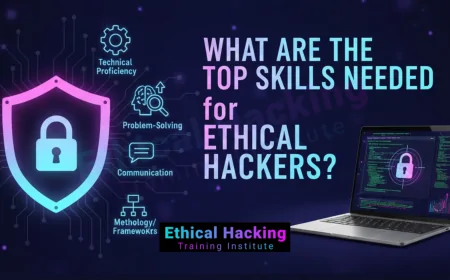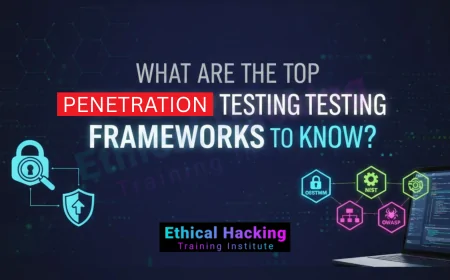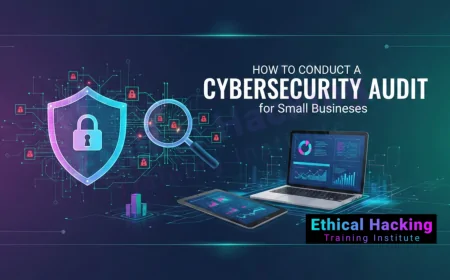Mobile Hacking Course: Learn to Protect Mobile Devices from Cyber Attacks | Learn to Hack and Secure Mobile Devices in This Expert Training Program
Master mobile hacking and security techniques with hands-on training in Android and iOS security. Learn to detect, exploit, and prevent cyber threats on mobile devices.

Table of Contents
- Introduction
- Why Mobile Security Matters
- Course Overview & Objectives
- Module Outline
- Tools & Platforms Covered
- Hands‑On Lab Exercises
- Secure Coding & App Hardening
- Mobile Malware & Reverse Engineering
- Mobile Network & Data Interception
- Mobile Pen‑Test Methodology
- Certification & Career Paths
- Who Should Enroll?
- Training Formats & Delivery
- Cost, Value & ROI
- Tools Comparison Table
- Real‑World Benefits
- FAQs
- Conclusion
Introduction
The explosion of mobile devices has significantly increased the attack surface for cyber threats. A comprehensive Mobile Hacking Course equips practitioners with skills to identify and mitigate mobile-specific vulnerabilities in Android and iOS ecosystems. From secure code practices to pentesting frameworks, this training bridges theoretical knowledge with practical defense mechanisms.
Why Mobile Security Matters
- Ubiquity: Billions use smartphones daily for banking, messaging, and work.
- High-value targets: Mobile data includes personal, corporate, and financial information.
- App ecosystem risk: Unvetted apps can compromise device integrity.
- Network exposure: Public Wi-Fi, Bluetooth, and mobile networks are susceptible to attack.
- Compliance requirements: GDPR, HIPAA, and PCI-DSS cover mobile data security.
Course Overview & Objectives
This training prioritizes:
- Understanding mobile OS architecture (Android/iOS)
- Learning to identify platform and application-level vulnerabilities
- Mastering tools for pentesting, malware analysis, reverse engineering
- Gaining hands-on laboratory experience
- Learning secure coding and mitigation strategies
- Preparing for mobile security certifications like OSMPT, GWAPT, MBP
Module Outline
- Mobile Security Fundamentals: OS architectures, sandboxing
- Android Pentest: APK inspection, rooting, privilege escalation
- iOS Pentest: Signing, jailbreaking, code injection
- Mobile Network Attacks: Wi-Fi, Bluetooth, MITM, SSL pinning bypass
- Mobile App Hacking: OWASP Mobile Top 10 vulnerabilities
- Mobile Malware & RE: Decompilation, unpacking, dynamic RE
- Reverse Engineering: Smali, JADX, class-dump
- Secure Coding & Hardening: Code obfuscation, data protection, best practices
- Penetration Testing Methodology: Recon, exploitation, reporting
- Security Automation: SAST, DAST for mobile
- Real-World Case Studies: Analysis of documented breaches and remediation
Tools & Platforms Covered
- Android: adb, apktool, JADX, Frida, Objection, Burp Suite mobile proxy
- iOS: ideviceinstaller, class-dump, Cycript, Frida
- Mobile Network: mitmproxy, Wireshark, Bettercap
- Mobile Malware RE: Ghidra, Hopper Disassembler, radare2
- Mobile Pentest Automation: MobSF, Drozer
Hands‑On Lab Exercises
Labs simulate real scenarios:
- APK re-signing and sideloading modified apps
- SSL pinning bypass on Android/iOS
- Privileged escalation on rooted/jailbroken environments
- Malware reverse engineering to uncover C2 behaviors
- Network interception through proxy and MITM
- Identifying insecure data storage in app sandbox
Secure Coding & App Hardening
Trainees learn:
- Android/iOS best practices
- Secure data storage methods
- Proper handling of crypto APIs
- App obfuscation and anti‐tampering strategies
Mobile Malware & Reverse Engineering
The course includes:
- Dynamic and static malware analysis
- Identifying ransomware and keyloggers implementations
- Exploring C2 communications, binary unpacking
Mobile Network & Data Interception
Attacks covered:
- Cellular protocol analysis (SS7, LTE)
- Wi‑Fi Evil Twin nests, DeAuth attacks
- Bluetooth exploitation vectors
- Local MITM and rogue proxies
Mobile Pen‑Test Methodology
- Recon: Discover endpoints & APIs
- Asset Enumeration: APK analysis, file permissions
- Exploit: Injection, root/jailbreak vulnerabilities
- Post‑Exploit: Data exfiltration and pivoting
- Report: Structured triage, remediation suggestions
Certification & Career Paths
After the course, consider:
- Certifications: OSMPT, GWAPT, OSWE-Mobile, MBP, MAPT
- Roles: Mobile Security Engineer, Pentester, App Security Auditor, Malware Researcher
- Industries: Banking, Healthcare, Tech, IoT, Enterprise Applications
Who Should Enroll?
- App developers wanting to secure Android/iOS apps
- Penetration testers seeking mobile specialization
- Security analysts responsible for mobile threats
- Students aiming to enter cybersecurity mobile domain
Training Formats & Delivery
- Self‑paced: Online video + lab VMs
- Live Online Instructor‑Led: Interactive, Q&A, dedicated lab time
- Bootcamp (3–5 days): Immersive lab‑heavy schedules
- Hybrid: Mix classroom/online self‑study
- Corporate Onsite: Customized programs for organizational needs
Cost, Value & ROI
Typical pricing (India): ₹30,000–₹90,000 for full course + 6–12 months lab access. Global rates: $1,200–$3,500. ROI comes from higher-paying roles and enterprise contract opportunities in mobile security.
Tools Comparison Table
| Tool | Platform | Primary Function |
|---|---|---|
| Frida | Android/iOS | Dynamic instrumentation |
| Apktool / JADX | Android | Reverse & decompile |
| NetHunter | Android | Mobile pentest distro |
| mitmproxy | Cross‑platform | HTTP/S MITM |
| MobSF | Cross‑platform | Static/Dynamic analysis suite |
| Ghidra | Cross‑platform | Reverse engineering |
Real‑World Benefits
- Proactively secure mobile applications before threats hit production
- Demonstrate expertise in secure mobile development/pentesting
- Qualify for mobile‑specific roles and consulting gigs
- Improve corporate compliance & threat posture in enterprise deployments
FAQs
1. Is mobile hacking legal?
Only when performed on devices/systems you own or with explicit permission.
2. Do I need coding to enroll?
Basic scripting (Java, Python) helps, but not mandatory for beginners.
3. Can I test on my phone?
Yes—use emulators or rooted/jailbroken devices in safe lab environments.
4. What OS is covered?
Both Android and iOS platforms are covered in depth.
5. What certifications are tied to mobile pentesting?
Certifications include OSMPT, GWAPT, OSWE‑Mobile, MBP, MAPT.
6. Is lab environment complex to set up?
No—VMs and guided setups are included in most structured courses.
7. Does this course include malware analysis?
Yes—you’ll learn to reverse engineer and dissect mobile malware behaviors.
8. Will I learn network-based attacks?
Yes—Wi-Fi MITM, Bluetooth exploits, SSL pinning bypass are taught.
9. Can self-taught individuals succeed?
Yes with discipline, but structured courses accelerate progress with labs and guidance.
10. How long is the complete course?
Ranges from 4 weeks (part-time) to 3‑5 days bootcamps intensive format.
11. What is Frida used for?
Dynamic instrumentation to intercept runtime behavior of mobile apps.
12. Will I learn on-device malware detection?
Yes—tools like MobSF, YARA, and sandbox monitoring are included.
13. Is secure coding in course heavy?
Yes—you’ll implement data encryption, code obfuscation, and best practices.
14. Are case studies included?
Yes—recent real-world mobile breaches and their mitigation strategies are studied.
15. Can I attend remotely?
Yes—live online and self-paced options are widely available.
16. Is this course suited for managers?
Partially—only high-level modules; technical managers may benefit, but labs are developer-focused.
17. What career roles follow this training?
Mobile security engineer, pentester, app auditor, malware analyst.
18. Can this training help bug bounty work?
Absolutely—mobile bug bounties are growing and this training provides strong prep.
19. What is SSL pinning bypass?
Techniques to override certificate validation in apps to inspect encrypted traffic.
20. What’s the next step after this course?
Specialized certifications like OSWE‑Mobile, MAPT, or advanced malware research.
Conclusion
A comprehensive **Mobile Hacking Course** empowers you to secure mobile technologies in today’s cyber threat landscape. Through mobile OS understanding, secure coding, exploitation techniques, malware analysis, and pentesting, you'll openly defend real-world assets. Whether you're a developer, pentester, or analyst, this training positions you as a key defender in mobile security.
What's Your Reaction?
 Like
0
Like
0
 Dislike
0
Dislike
0
 Love
0
Love
0
 Funny
0
Funny
0
 Angry
0
Angry
0
 Sad
0
Sad
0
 Wow
0
Wow
0


















